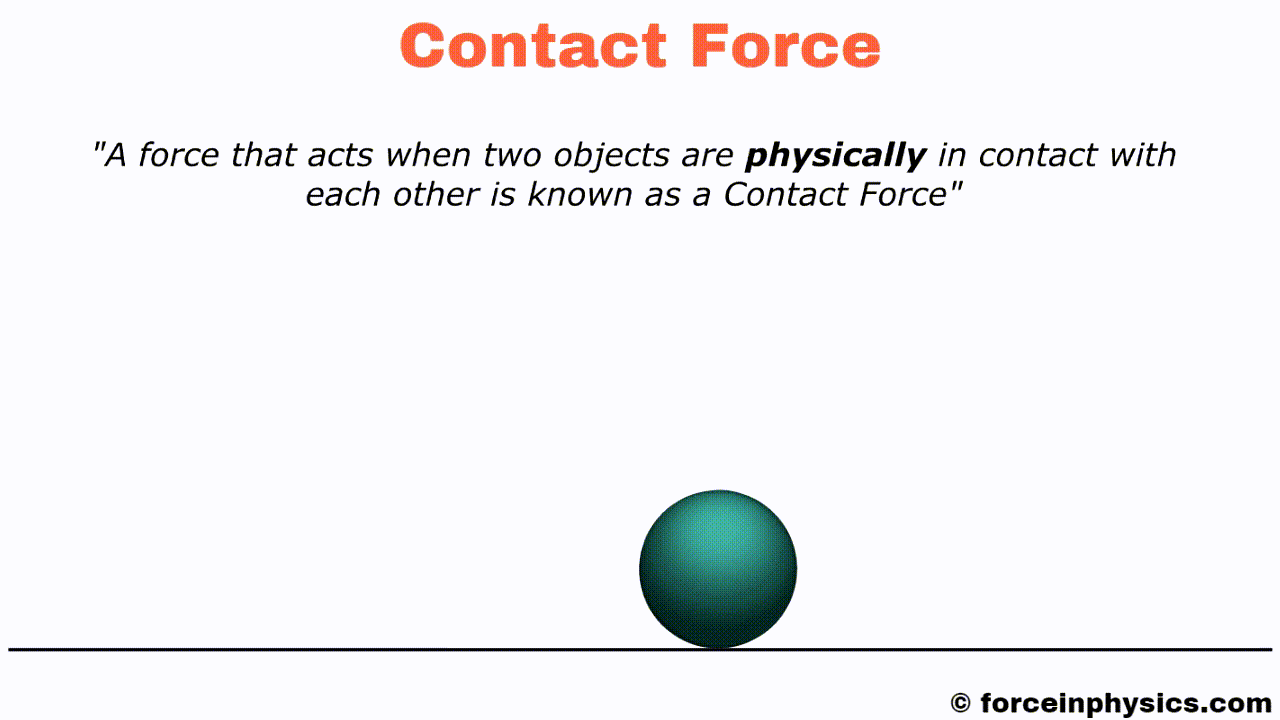
A contact force is a type of force that occurs when two objects are physically in contact with each other. It results from the interaction between objects that are in direct contact, as opposed to non-contact forces, which operate between objects without physical contact.
Examples
Kicking
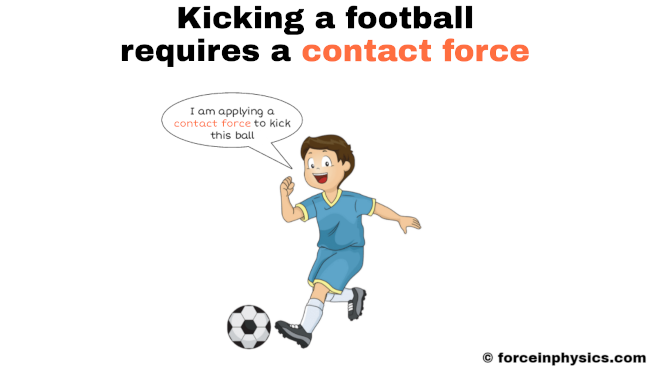
When a football player applies force with their leg to kick the football, a contact force arises as the football and the player’s leg come into direct contact. This contact force occurs due to the physical interaction between the objects at the moment of impact. It’s this contact force that enables the player to transfer energy to the football, propelling it forward and illustrating how contact forces involve the push or pull resulting from objects physically touching during an interaction.
Throwing
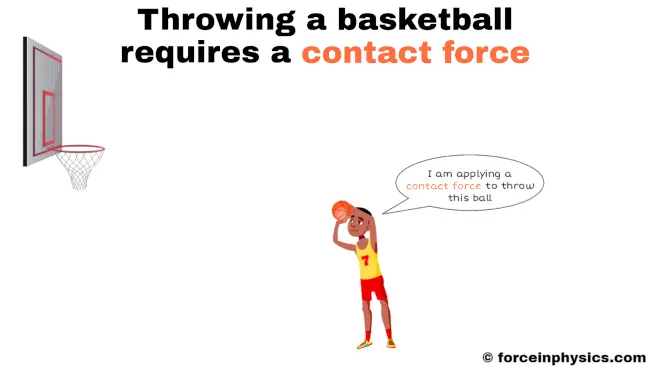
When a basketball player throws a basketball, a contact force comes into play. This force originates from the direct interaction between the player’s hand and the basketball. As the player exerts a push or pull on the ball, their hand physically touches the basketball’s surface, creating contact between the two objects. This contact force enables the player to transfer momentum and energy to the basketball, propelling it through the air. It exemplifies how contact forces facilitate actions involving physical touch and interaction between objects.
Pushing
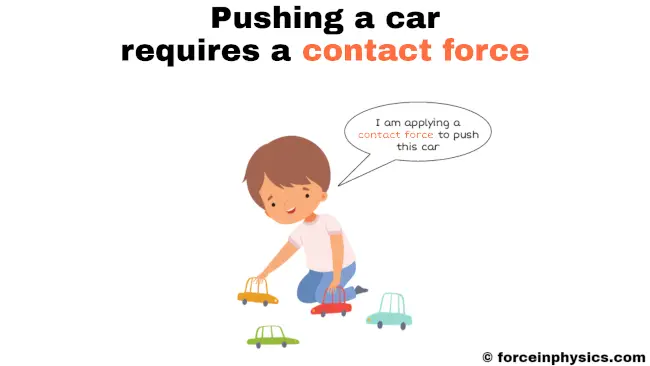
When a small child plays with a toy car and applies force with their hand to set the car in motion, they are demonstrating a contact force. In this scenario, as the child’s hand pushes the car, it comes into physical contact with the car, resulting in the application of force. This contact force is essential for the child to impart motion to the car, highlighting how contact forces arise when two objects are in direct contact and influence their interactions, as seen in this example.
Leaning
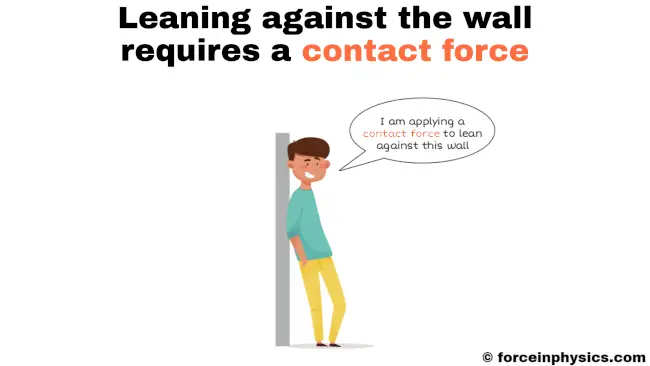
When a boy leans against a wall, a contact force is generated between his body and the wall. This contact force arises because the boy’s body is in direct contact with the wall. As he leans, his body applies a force to the wall, and in response, the wall exerts an equal and opposite force on his body. This interaction demonstrates contact forces, where objects in physical contact exert forces on each other, in this case, supporting the boy’s weight and preventing him from falling.
Hitting
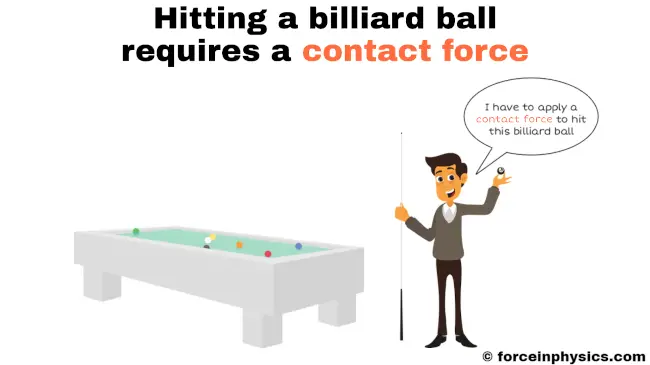
When a man aims to strike a billiard ball using a cue stick, he applies force to the ball through the stick. This action creates contact between the billiard ball and the cue stick, resulting in the generation of a contact force. Contact forces, exemplified in this scenario, arise when two objects – in this case, the cue stick and the billiard ball – come into direct physical contact, resulting in the application of force through their interaction.
Pulling
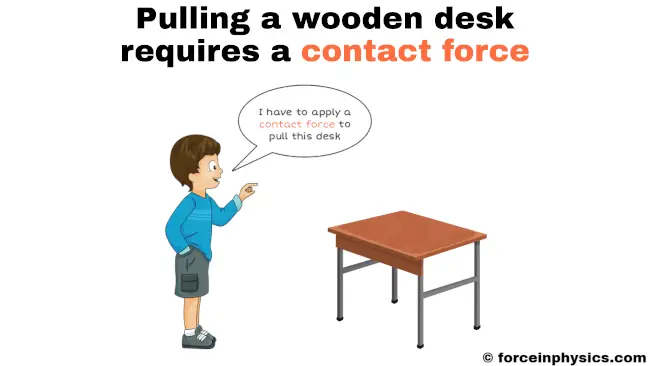
In the scenario of pulling a wooden desk, a contact force comes into play. When the boy aims to move the wooden desk, he directly interacts with it by touching it with his hand. This physical contact between the boy’s hand and the wooden desk generates a contact force. Contact forces, exemplified here, occur when two objects – in this case, the wooden desk and the boy’s hand – come into direct contact, resulting in the application of force through their physical interaction. This force enables the boy to pull the desk, illustrating how contact forces are integral to actions involving physical touch between objects.
Plucking
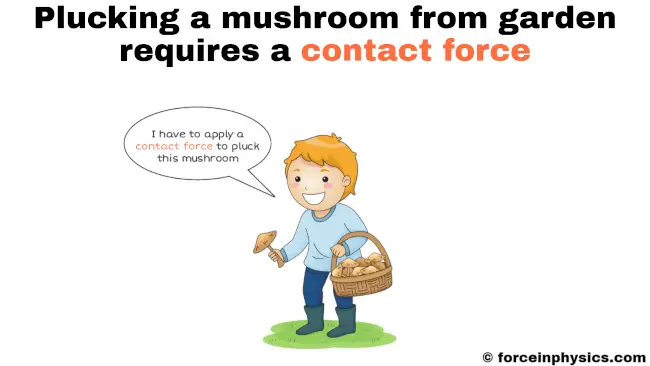
When a boy plucks a mushroom from the ground, contact force comes into play. As he exerts force with his hand to detach the mushroom, direct physical interaction occurs between his hand and the mushroom. This interaction leads to the application of a contact force between the two objects: the mushroom and his hand. The contact force in this case is what allows the boy to successfully pluck the mushroom, as it results from the direct contact between the objects involved in the action.
Flipping
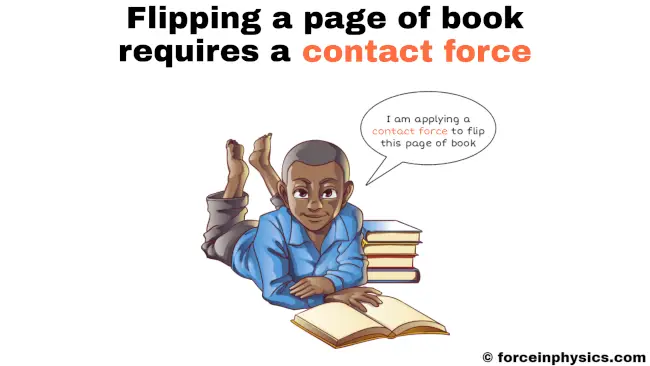
When a boy flips the page of a book, contact forces are at play. His application of force through his hand onto the book’s page results in the page flipping. This force arises due to direct contact between his hand and the page, illustrating how contact forces occur when two objects, in this case, the page and the boy’s hand, physically interact, leading to the application of force through their direct touch, resulting in the page’s movement.
Picking
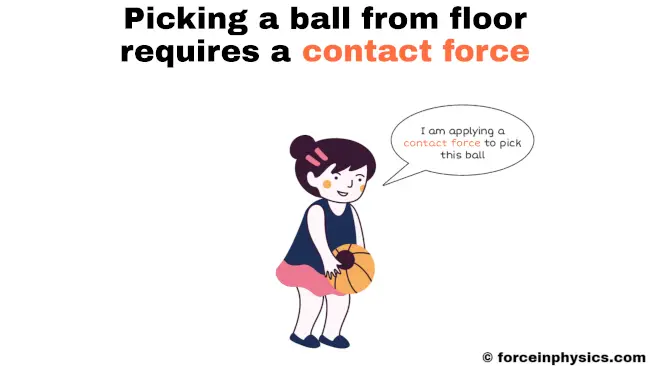
As a small girl picks a ball from the floor, she exerts force using her hand. The action of picking involves direct physical contact between her hand and the ball. This contact leads to the emergence of a contact force between the two objects – the ball and her hand. Contact forces, as exemplified here, arise when two objects – in this case, the hand and the ball – come into direct physical contact, leading to the application of force through their interaction during the process of picking up the ball.
Types
Muscular force

A boy is using muscular force to push a heavy stone. This force arises from the contraction of his muscles, especially in his hands, allowing him to exert the effort needed to move the stone. Muscular force, a type of contact force, is generated when muscles contract to create a push or pull, as shown in this scenario where the boy’s muscle strength propels the stone forward.
Friction
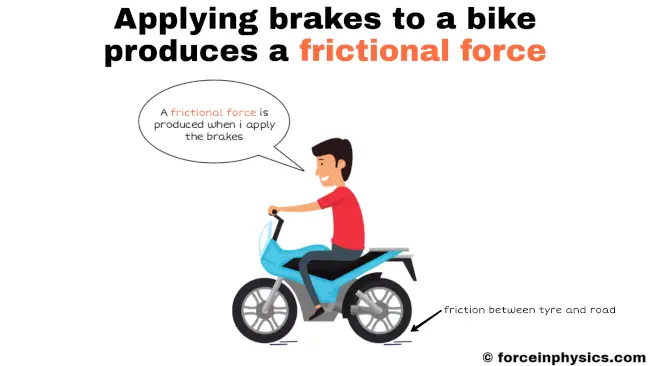
When a person applies the brakes to a bike, friction becomes a crucial factor. As the brakes are engaged, the bike’s tires come into contact with the road surface and slide against it. This interaction generates a force known as friction, which acts to oppose the bike’s motion. Essentially, friction is the force that effectively stops the bike. It’s important to note that friction always acts in the direction opposite to the object’s motion, as demonstrated in this braking scenario.
Tension
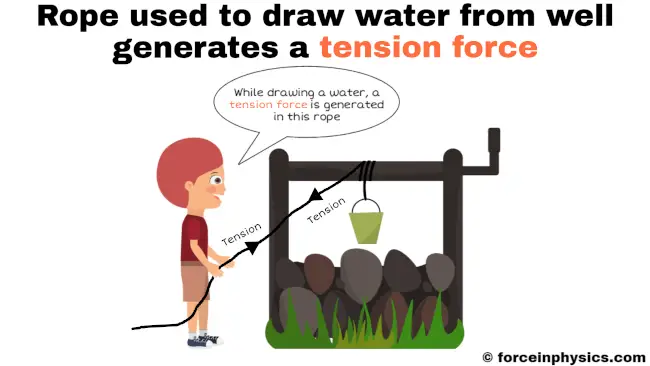
When a boy pulls a rope to draw water from a well, tension occurs in the rope. This tension arises because the rope is being pulled in opposite directions, with the boy pulling upward and the weight of the water-filled bucket pulling downward. Tension is the internal force within the rope that results from these opposing forces, leading the rope to resist being pulled apart.
Applied force
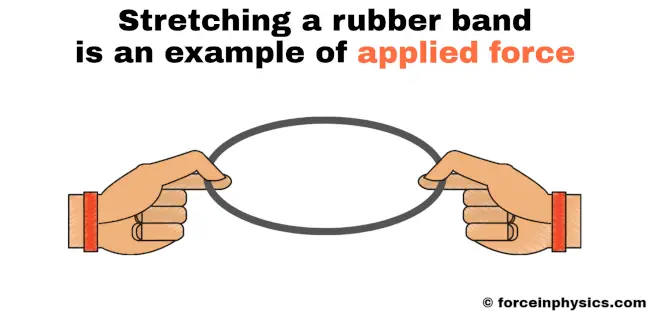
Applied force refers to the effort exerted on an object to make it move, change its speed, or alter its shape. For example, when you push a door to open it, your hand applies force to the door. Similarly, when you stretch a rubber band by pulling it with your fingers, you’re applying force to the rubber band. This concept helps us understand how external factors affect the behavior of objects in the world, whether in everyday activities or scientific experiments.
Normal force
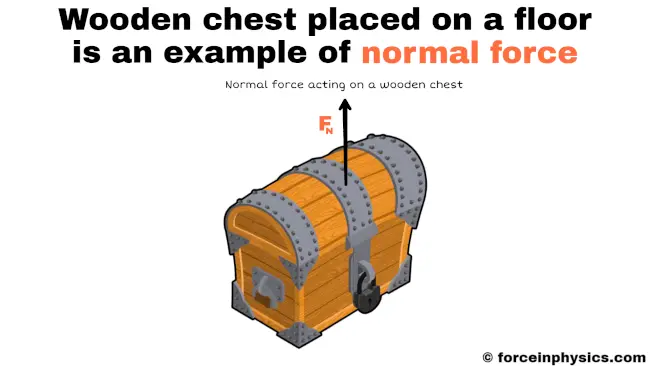
When a wooden chest is placed on a floor, it experiences a perpendicular force exerted by the floor, which prevents it from falling through. This force, known as the normal force, acts perpendicular to the surface of the chest, supporting its weight and preventing it from sinking into the floor.
Drag
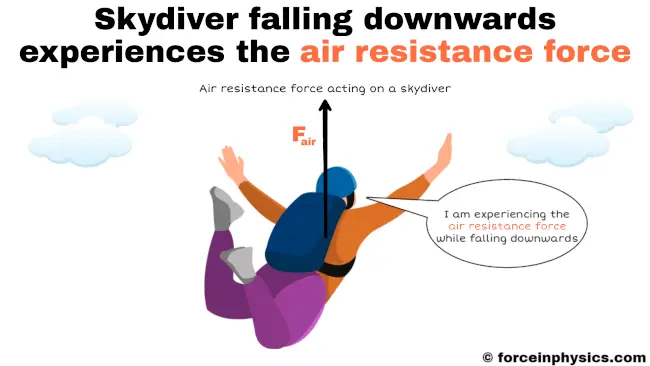
As a skydiver descends in freefall, they encounter an upward force exerted by the air, which opposes their downward motion. This opposing force, commonly known as air resistance or drag, acts in the opposite direction to the skydiver’s movement, slowing their descent and affecting their trajectory.
Mechanical force
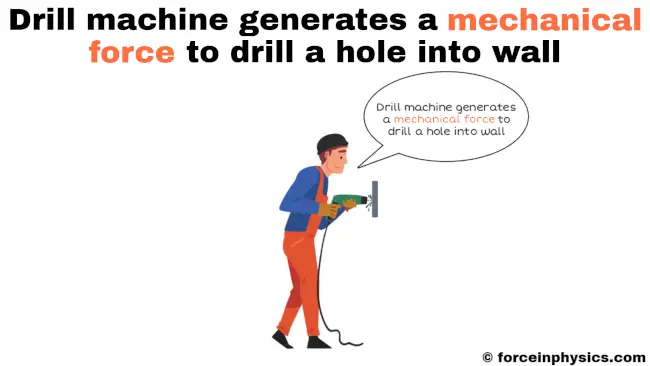
When a drill machine creates a hole in a wall, it applies mechanical force through the rotating drill bit, which cuts into the material. The drill’s motor generates torque, causing the bit to spin rapidly, while the drill is pressed into the wall. The sharp edges of the bit remove material as it rotates, gradually forming a hole by displacing and breaking down the wall material. This process illustrates how mechanical force, involving both rotational motion and direct force, can alter the structure of solid objects.
Spring force
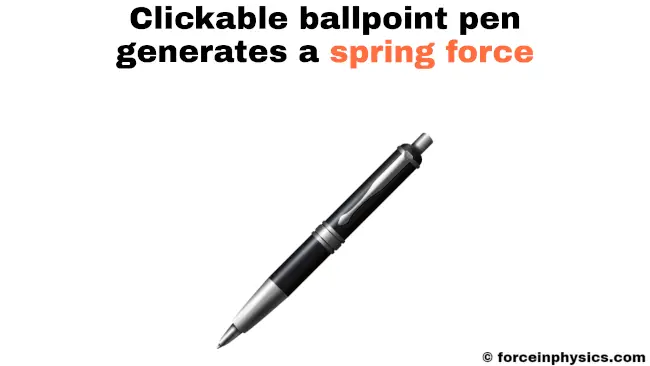
When pressure is applied to a clickable ballpoint pen, a force is produced as the pen’s internal spring gets compressed. This force, resulting from the spring’s compression, leads to the extension of the pen’s point and is commonly referred to as spring force.
Related
- Balanced force
- Unbalanced force
- Friction
- Tension (physics)
- Applied force
- Normal force
- Drag (physics)
- Gravity
- Centripetal force
- Centrifugal force
- Buoyancy
- Net force
- Compression (physics)
More topics
External links
- Contact force – Wikipedia
- Contact & Non-contact Forces: Definition, Types, & Examples – Science Facts
- Contact Forces: Examples & Definition – Vaia
- Contact Forces (video) – Khan Academy
- Contact forces – GCSE Physics (Single Science) Revision – BBC
- The Meaning of Force – The Physics Classroom
- Contact & Non Contact Forces: Differences, Examples and more! – Study Mind
- High School Physics : Contact Forces – Varsity Tutors
- Contact forces – IOP Spark
- contact and non-contact forces – Dynamic Science
- Is contact force repulsive or attractive? – Physics Stack Exchange
- 2.3 Contact Forces – Fiveable
- What does contact force mean? – Definitions.net
- Contact and Non-Contact Forces – Shalom Education
- Contact force – Evolving Sciences
- How to Calculate Contact Force – Sciencing
Deep
Forceinphysics.com was founded by Deep Rana, who is a mechanical engineer by profession and a blogger by passion. He has a good conceptual knowledge on different educational topics and he provides the same on this website. He loves to learn something new everyday and believes that the best utilization of free time is developing a new skill.
